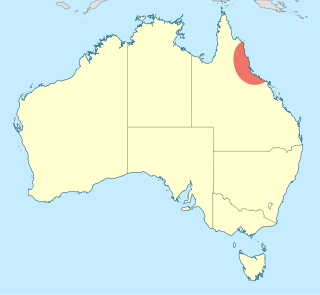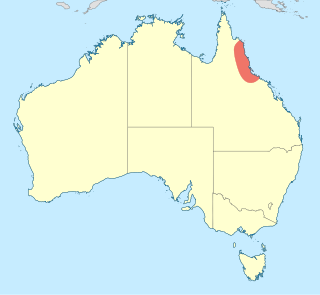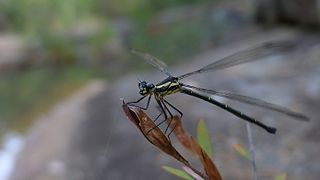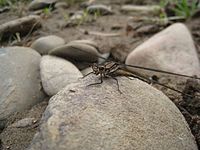
Griseargiolestes albescens is a species of Australian damselfly in the family Megapodagrionidae. It is commonly known as a coastal flatwing.

Diphlebia is a genus of damselflies in the family Lestoideidae. They are commonly known as rockmasters. These damselflies are very large and thick. The species in this genus are found in Eastern Australia, except for one species that can be found in New Guinea. The males are vividly patterned. They are blue or bluish green and black in colour. Their blue colour also gives them the name azure damselflies. They rest with their wings spread out. Their wings are usually blackish brown or have white markings. These damselflies have several present antenodal crossveins. The two basal crossveins extend across costal and subcostal spaces. The larvae are wide and flat. They have long saccoid gills enabling them to breathe underwater. The inner tooth of their labial palps is elongated. The specific characters of the larva are mid-ventral, distal width, basal width, and length of median lobe.

Diphlebia euphoeoides, sometimes spelled Diphlebia euphaeoides, known as the tropical rockmaster is an Australian species of broad winged damselfly. It is one of a group known as the azure damselflies. It is found in Queensland (Australia) and Papua New Guinea. It typically occurs near lakes, waterfalls or streams at relatively low altitudes, and is occasionally seen near dry pools.

Diphlebia coerulescens, known as the sapphire rockmaster is an Australian species of broad winged damselfly. It is one of a group known as the azure damselflies. It is found in Queensland and north-eastern New South Wales in eastern Australia, where it is found in fast-flowing streams and rivers.

Miniargiolestes is a monotypic genus of damselflies in the family Megapodagrionidae. The single species of this genus, Miniargiolestes minimus, commonly known as a stream flatwing, is a small damselfly, metallic black to green in colour with white markings. It is endemic to south-western Australia, where it inhabits streams.

Agriocnemis rubricauda is a species of Australian damselfly in the family Coenagrionidae, commonly known as a red-rumped wisp. It is a small damselfly; the male has a red end to his tail. It has been recorded from northern Australia where it inhabits boggy seepages and swamps.

Archibasis mimetes is a species of damselfly in the family Coenagrionidae, commonly known as a blue-banded longtail. It is a medium-sized damselfly; the male is bright blue and black. It has been recorded from New Guinea and northern Australia, where it inhabits streams.

Coenagrion lyelli is a species of damselfly in the family Coenagrionidae, commonly known as a swamp bluet. It is a medium-sized damselfly, the male is bright blue with black markings. It is found in south-eastern Australia, where it inhabits streams, pools and lakes.

Neosticta canescens is a species of damselfly in the family Isostictidae, commonly known as a southern pinfly. It can be found in eastern Australia, where it inhabits streams.

Austrolestes aridus is an Australian species of damselfly in the family Lestidae, commonly known as an inland ringtail. It is widespread across inland Australia, where it inhabits streams, pools, and ponds.

Austrolestes insularis is an Australian species of damselfly in the family Lestidae, commonly known as a northern ringtail. It is widespread across northern Australia, where it inhabits streams, pools, and ponds.

Diphlebia hybridoides is a species of Australian damselfly in the family Lestoideidae, commonly known as a giant rockmaster. It is endemic to north-eastern Queensland, where it inhabits streams in forests.

Diphlebia lestoides is a species of Australian damselfly in the family Lestoideidae, commonly known as a whitewater rockmaster. It is endemic to south-eastern Australia, where it inhabits streams and rivers.

Austroargiolestes alpinus is a species of Australian damselfly in the family Megapodagrionidae, commonly known as a New England flatwing. It is endemic to north-eastern New South Wales, where it inhabits streams and bogs.

Austroargiolestes chrysoides is a species of Australian damselfly in the family Megapodagrionidae, commonly known as a golden flatwing. It is endemic to south-eastern Queensland, where it inhabits streams in rainforest.

Austroargiolestes aureus is a species of Australian damselfly in the family Megapodagrionidae, commonly known as a tropical flatwing. It is endemic to north-eastern Queensland, where it inhabits streams in rainforest.

Griseargiolestes eboracus is a species of Australian damselfly in the family Megapodagrionidae, commonly known as a grey-chested flatwing. It is endemic to eastern Australia, where it inhabits bogs.

Griseargiolestes fontanus is a species of Australian damselfly in the family Megapodagrionidae, commonly known as a springs flatwing. It is endemic to south-eastern Queensland and north-eastern New South Wales, where it inhabits streams near their springs.

Griseargiolestes intermedius is a species of Australian damselfly in the family Megapodagrionidae, commonly known as an alpine flatwing. It is endemic to alpine areas of Victoria and New South Wales, where it inhabits bogs and seepages.

Episynlestes albicauda is a species of Australian damselfly in the family Synlestidae, commonly known as a southern whitetip. It is endemic to south-eastern Queensland and north-eastern New South Wales, where it inhabits streams and pools in rainforests.



























